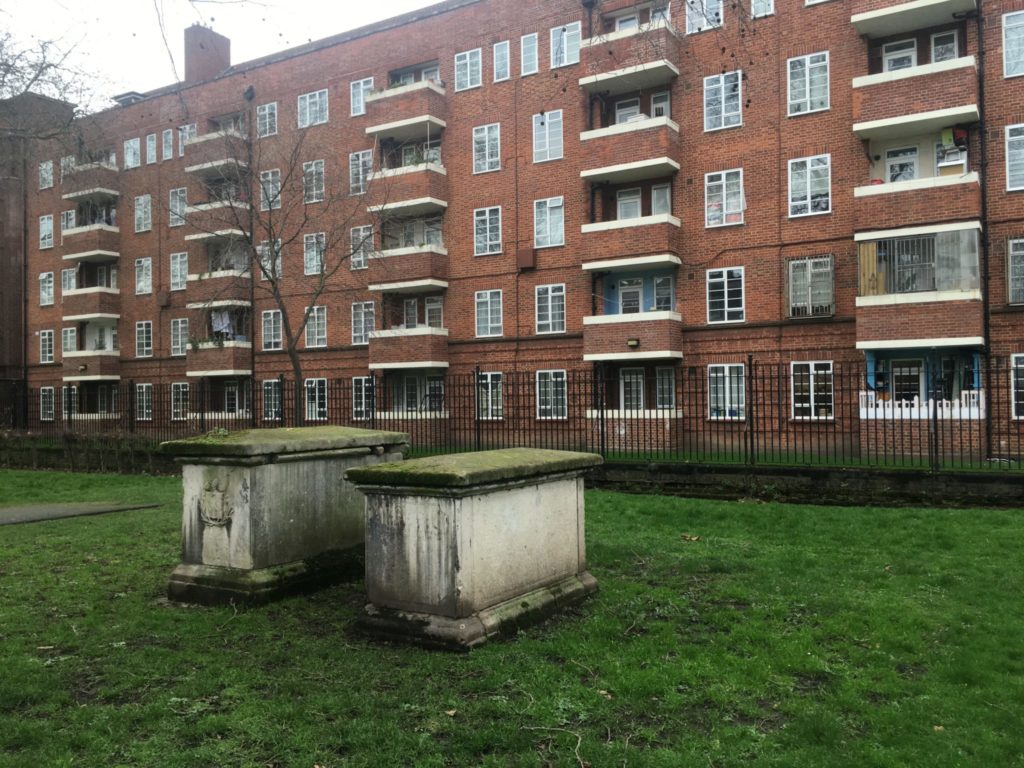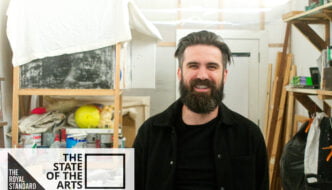
At first glance, St. Thomas’s Long Burial Ground seems an unremarkable place. If you happen to be on Well Street in Hackney, London, you can walk right past it, as I first did on my recent visitation. It took me a moment to realise that the narrow stretch of grass behind the railings — around sixty feet across — was the place I was looking for.
Entering the burial ground (which for all intents and purposes can be called a garden) I felt instantly disorientated by the odd dimensions of the place. There is a reason why it is called St. Thomas’s Long Burial Ground, because, in relation to its narrowness, it is exceedingly long, stretching the length of the twenty-five stylish terrace houses that flank it on one side. The garden is made all the more spatially strange by the seven large plane trees staggered either side of the path dividing its centre. The trees reach as high as the roofs of the counsel flats that border the opposite side of the space.
I found myself staring down at a marble flat grave in the centre of the garden. The engraving was largely faded, but I could just about make out the names of Charles and Rebecca Newby, followed by the epitaph: “A warmer heart death ne’er made cold.” Further down were two illegible names followed by the words: “children of the above.” A family tomb. The only semblance of a date I could decipher was eighteen-thirty-something.
I walked the length of the path and sat on a bench at the end of the garden, feeling enclosed in a world far removed from the shops and cafes visible on the adjoining street. There is nothing like a smattering of centuries-old gravestones to breed a macabre atmosphere, ever heightened by the surrounding residential normality. Perhaps it was my knowing the history of the place, but even in the light of day the garden emanated a ghostliness.
Up until 1876, the space was used as a cemetery for a local chapel. Most of the gravestones were moved when the cemetery was converted in 1884. It is unclear why only a few remain, and what significance the dead may have to the location, but the enduring memorials serve as a sign of the twisting histories of all places. Every place is a scattered story. Who knows what stood in the garden before it was a cemetery, and further back, before London was London? The land has always been there.
I thought I was alone, but then I saw a man at the other end of the garden, resting against one of the bins. He placed a red plastic bag on top of the bin and looked around, then up to the trees. Reaching into the bag, he proceeded to sprinkle handfuls of breadcrumbs across the grass. Within seconds, dozens upon dozens of pigeons surrounded him, all battling for a scrap.
I walked back down the path, kicking through the spiky fruits fallen from the plane trees. I strayed onto the grass to observe two moss-covered chest tombs rising from the earth near the entrance. The inscriptions were far too faded to read. There was a disquieting crack below the lid of the smaller tomb; I could see into its black insides. I can only assume it was not entirely empty.
Just before I exited the park, a woman came in pushing a pram in which lay a beautiful baby, hardly six months old. The woman and I exchanged a smile as we passed at the gate, before she turned, manoeuvring the pram into the burial ground.
Michael Sutton is a writer, artist and musician based in Liverpool. Several of his poems appear in ‘Give Poetry A Chance: The Anthology’, available now from lulu.com (all proceeds donated to Souse Kitchen). His sculpture ‘Birdhouse Sunrise Reconstructed’ is currently on display at the Museum of Futures in Surbiton. His band Come Bubbles are performing at Sound Basement in Liverpool on Saturday 28th of March.
Filed under: Community
Tagged with: geographies, gravestones, hidden, history, London, normality, place, residential, setting, st thomas long burial ground, text, writing



Comments